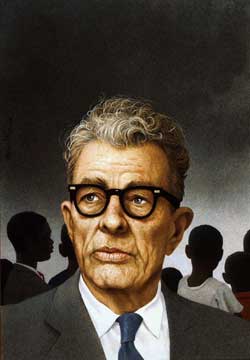Everett Dirksen: Forgotten Civil Rights Champion

National Portrait Gallery, Smithsonian Institution;
gift of Time magazine
June 10, 1964, was a dramatic day in the United States Senate. For the first time in its history, cloture was invoked on a civil rights bill, ending a record-breaking filibuster that had consumed fifty-seven working days. The hero of the hour was minority leader Senator Everett McKinley Dirksen (R-Ill.).
Dirksen, who had little support among Chicago’s black voters and who had been picketed at his home by rights activists, took pains to point out that he was “no Johnny-come lately” to civil rights legislation. During his sixteen years in the House of Representatives, he had voted for anti-poll-tax and anti-lynching measures. In the Senate he had sponsored or cosponsored scores of bills dealing with civil rights. But as an omnibus civil rights bill began to near passage in the House early in 1964, Dirksen, a pragmatic legislator and a consummate compromiser, realized that its provisions were too drastic for passage in the Senate.
In February, when he entered the hospital, afflicted with a bleeding ulcer, he took his dog-eared copy of the House bill with him, poring over it line by line and drawing up a list of conciliatory changes. During the spring, with the help of legal experts, he began to rewrite the bill, suggesting almost seventy amendments, many technical but others of substance. “I have a fixed pole star,” he said in April. “This is, first, to get a bill; second to get an acceptable bill; third, to get a workable bill; and, finally, to get an equitable bill.”
In the beginning, Dirksen could only guarantee that twelve to fourteen of his thirty-three Republicans would join with floor manager Hubert Humphrey’s solid forty-one Democrats, leaving the total short of the sixty-seven votes necessary to shut down the southern Democrats. “The key,” said majority leader Mike Mansfield, “is Dirksen.” Dirksen himself acknowledged, “Getting cloture is going to be as difficult as hell.” He went to his members one by one, pleading with them, appealing to their moral sensibilities, reminding them of past favors, and warning of more civil unrest, exercising his beguiling talents to their fullest effect.
By June 10, the stage was set. The Democratic senator from West Virginia, Robert C. Byrd, sat down after speaking for fourteen hours and thirteen minutes, and Senator Richard Russell of Georgia summed up for the southern opposition. Senator Dirksen then took the floor. “Stronger than all the armies is an idea whose time has come,” he said, quoting Victor Hugo in his basso profundo voice. “The time has come for equality of opportunity in sharing in government, in education, and in employment. It will not be stayed or denied. It is here.”
Dirksen produced twenty-three Republican votes to make a total of sevemty—three votes beyond the necessary two-thirds to break the filibuster (the final tally was 71–29). Swift passage of the civil rights bill followed, and the House, rather than argue, accepted the Senate version. On July 2, President Lyndon Johnson signed into law a bill that banned discrimination in public facilities, provided voting rights protection, and established equal opportunity as the law of the land.
Time magazine noted when Dirksen appeared on the cover of the June 19, 1964 issue, “it is Dirksen’s bill, bearing his handiwork more than anyone else’s.” That cover, by Robert Vickrey, the accomplished painter in egg tempera, is part of the Time collection of artwork that was presented to the National Portrait Gallery in 1978.